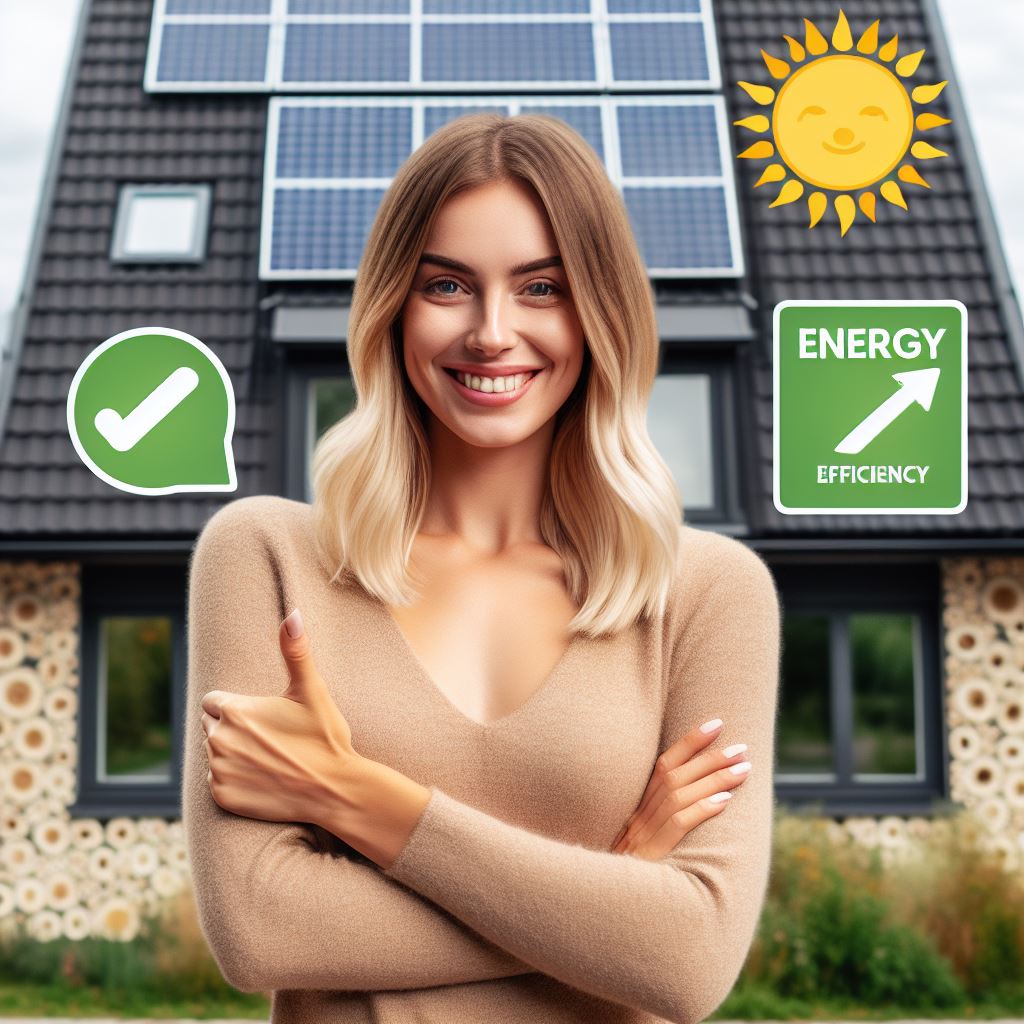Introduction
Sustainable living refers to the practice of using resources in a way that preserves the environment for future generations.
It is becoming increasingly important in the US real estate market as consumers prioritize eco-friendly solutions.
In this blog post, we will explore the concept of sustainable living, its significance in the US real estate market, and provide a preview of the content to come.
Sustainable living involves adopting lifestyles and making choices that minimize negative impacts on the environment and promote long-term ecological balance.
The US real estate market is recognizing the significance of sustainable living as consumers demand environmentally friendly homes.
Builders and developers are incorporating green features to address this growing market trend.
We will delve into various aspects of sustainable living in the US real estate market, including energy-efficient construction, use of renewable materials, and the incorporation of smart technologies.
Additionally, we will discuss the financial and health benefits associated with sustainable homes.
Throughout this blog, we will highlight successful sustainable living practices implemented by developers, case studies of eco-friendly homes, and the role of government policies in promoting sustainable living.
It will provide readers with valuable insights into how they can embrace sustainable living practices within the US real estate market.
In essence, sustainable living is pivotal in the US real estate market as it aligns with consumers’ increasing desire for eco-friendly solutions.
By incorporating sustainable practices, the industry can contribute to a greener future while meeting the evolving demands of environmentally conscious buyers.
Evolution towards Sustainable Living in the US
Sustainable living has gained significant traction in the United States over the years, driven by a growing interest and demand for environmentally-friendly housing options.
People are becoming increasingly aware of the impact their lifestyle choices have on the environment and are actively seeking ways to minimize their carbon footprint through sustainable living practices.
A. Growing interest and demand for sustainable housing
The shift towards sustainable living can be attributed to the increasing interest and demand for sustainable housing options.
People are now more knowledgeable about the benefits of living in an eco-friendly environment, including reduced energy consumption, lower utility bills, and improved indoor air quality.
With a focus on reducing their environmental impact, individuals are seeking out homes that are built using sustainable materials, incorporate energy-efficient technologies, and utilize renewable energy sources such as solar panels.
This demand has led to a rise in green home construction and renovation projects across the country.
B. Development of green building certifications and standards
To meet the rising demand for sustainable housing, various green building certifications and standards have been developed.
These certifications, such as LEED (Leadership in Energy and Environmental Design), provide guidelines and benchmarks for constructing and operating sustainable buildings.
Builders and developers are pursuing these certifications to showcase their commitment to sustainability and to attract environmentally-conscious buyers.
These certifications consider factors such as energy efficiency, water conservation, materials selection, and indoor environmental quality, ensuring that sustainable homes meet stringent environmental standards.
C. Incentives and government policies supporting sustainable living
The US government has recognized the importance of sustainable living and has implemented incentives and policies to support the development of sustainable homes.
Various federal agencies offer financial incentives, tax credits, and grants to encourage homeowners and builders to adopt sustainable practices.
Additionally, local governments have implemented zoning ordinances and building codes that promote sustainable construction and energy-efficient practices.
These policies provide further support and guidance to individuals and organizations looking to embrace sustainable living.
Essentially, the United States has witnessed a significant evolution towards sustainable living in recent years.
The growing interest and demand for sustainable housing, coupled with the development of green building certifications and the support of incentives and government policies, have driven this change.
As more individuals recognize the importance of sustainable living, there is a greater emphasis on constructing and renovating homes that are energy-efficient, use eco-friendly materials, and incorporate renewable energy sources.
This shift towards sustainable housing not only benefits the environment but also provides homeowners with long-term cost savings and improved quality of life.
Read: Real Estate Tech: Transforming US Homes
Sustainable Practices in US Real Estate
Sustainable living practices have become increasingly important in the United States.
As the need for environmental consciousness grows, various sectors, including the real estate industry, have adapted sustainable practices to reduce their carbon footprint and promote eco-friendly living.
A. Energy-efficient designs and construction
A key aspect of sustainable real estate development involves energy-efficient designs and construction.
By using solar panels and energy-efficient appliances, developers can significantly reduce energy consumption within buildings.
This not only benefits the environment but also cuts down on energy costs for residents.
Additionally, incorporating insulation and efficient Heating, Ventilation, and Air Conditioning (HVAC) systems further enhances a building’s energy efficiency.
B. Water conservation measures
Water conservation measures are crucial in sustainable living.
Low flow fixtures, such as toilets and faucets, minimize water usage without compromising functionality.
Rainwater harvesting systems collect and store rainwater for various purposes, further reducing reliance on freshwater resources.
Drought-resistant landscaping is another popular practice, as it requires less irrigation, ultimately conserving water.
C. Integration of renewable energy sources
Furthermore, the integration of renewable energy sources has gained traction in the US real estate market.
By installing wind turbines and geothermal systems, buildings can generate clean energy while reducing dependence on fossil fuels.
Net-zero energy buildings take sustainability a step further by aiming to produce as much energy as they consume.
These structures often rely on renewable energy sources like solar and wind power.
D. Waste reduction and recycling initiatives
Waste reduction and recycling initiatives are also significant components of sustainable living practices in real estate.
Developers focus on using construction materials that are environmentally friendly and recyclable.
Additionally, efficient waste management strategies are implemented to minimize construction waste and promote recycling.
Beyond construction practices, sustainable real estate initiatives extend to residential communities.
Recycling programs are encouraged, providing residents with the means to dispose of waste responsibly and promoting a circular economy.
Moreover, education and awareness campaigns are conducted to inform residents about sustainable practices and encourage their adoption.
In fact, US real estate has made substantial strides in adopting sustainable living practices.
Energy-efficient designs, water conservation measures, integration of renewable energy sources, and waste reduction initiatives are increasingly becoming the norm in the industry.
As awareness regarding environmental concerns continues to grow, sustainable practices are expected to shape the future of the US real estate market, contributing to a greener, more eco-friendly society.
Read: Cost-Efficient Building: 2024 US Insights

Benefits of Sustainable Living in the US Real Estate Market
A. Environmental Benefits
1. Reduction in Carbon Footprint
Sustainable living practices, such as using renewable energy sources like solar power and implementing energy-efficient technologies, significantly reduce the amount of carbon dioxide and other greenhouse gas emissions released into the atmosphere.
By minimizing reliance on fossil fuels for energy consumption, households contribute to mitigating climate change and its adverse effects on the environment.
2. Conservation of Natural Resources
Sustainable living emphasizes responsible resource management, including water conservation, efficient waste management, and the use of recycled materials.
By reducing consumption and waste generation, sustainable homes help preserve finite resources like water, forests, and minerals.
This conservation effort is crucial for maintaining ecological balance, protecting biodiversity, and ensuring the availability of resources for future generations.
B. Economic Advantages
1. Lower Utility Costs and Maintenance Expenses
Sustainable homes are designed to be energy-efficient, resulting in lower utility bills due to reduced electricity, heating, and cooling requirements.
Additionally, features such as durable, low-maintenance materials and efficient appliances decrease ongoing maintenance costs, saving homeowners money in the long run.
These savings enhance financial stability and improve the affordability of homeownership.
2. Potential Increase in Property Value
The growing awareness and demand for sustainable living options in the real estate market can lead to an appreciation in property value for homes with green certifications or eco-friendly features.
Energy-efficient upgrades, such as insulation, windows, and solar panels, enhance the overall attractiveness and marketability of properties, attracting environmentally conscious buyers and investors.
As a result, homeowners stand to gain higher returns on their investments while contributing to a more sustainable future.
C. Health and Well-being Improvements
1. Improved Indoor Air Quality
Sustainable homes prioritize indoor air quality by using non-toxic building materials, adequate ventilation systems, and air filtration technologies.
These measures reduce exposure to indoor pollutants such as volatile organic compounds (VOCs), mold, and allergens, thereby promoting respiratory health and reducing the risk of respiratory illnesses, allergies, and other health issues.
2. Enhanced Comfort and Living Conditions
Sustainable design principles focus on creating comfortable, functional living spaces that enhance occupants’ well-being and quality of life.
Features such as natural lighting, efficient heating and cooling systems, sound insulation, and ergonomic layouts contribute to a more comfortable and enjoyable living environment.
By prioritizing occupant comfort and satisfaction, sustainable homes support overall health and happiness, fostering a sense of belonging and community.
Read: Prefab Homes: Rising US Market Trends
Challenges and Future Outlook
A. Cost considerations and affordability
The cost of sustainable living options can be a significant challenge for many individuals.
Affordability is a key factor that determines whether people will choose sustainable living solutions.
The initial investment required for solar panels, energy-efficient appliances, and other sustainable upgrades can be high.
However, long-term savings on energy bills and potential government incentives can offset these costs.
Developers and manufacturers need to focus on reducing the cost of sustainable products to reach a wider market.
Affordable housing with sustainable features should be a priority to make sustainable living accessible to all.
B. Education and awareness about sustainable living
Lack of education and awareness is a major hurdle in promoting sustainable living practices in the US.
Many individuals are unaware of the impact their daily choices have on the environment.
Educational programs and campaigns are essential to inform people about sustainable living benefits.
Schools, community centers, and media should play a role in spreading knowledge about sustainable practices.
Encouraging sustainable habits from a young age will create a mindset of environmental responsibility.
C. Technological advancements and innovation
Technological advancements are driving the growth of sustainable living in the US market.
Innovative solutions such as smart home automation and energy management systems are becoming more accessible.
Advances in renewable energy technologies, such as solar and wind power, are making sustainable living more feasible.
New materials and construction techniques are being developed to enhance the energy efficiency of buildings.
Continued investment in research and development will further accelerate the adoption of sustainable practices.
D. Anticipated growth and future trends in the US real estate market
The US real estate market is expected to see significant growth in sustainable living options.
Eco-friendly features and certifications like LEED and ENERGY STAR are becoming increasingly desirable.
Green buildings offer a competitive advantage, attracting environmentally-conscious consumers and tenants.
Real estate developers and stakeholders are recognizing the benefits of sustainable construction and retrofits.
The integration of sustainable living into urban planning is crucial to creating eco-friendly communities.
Future trends suggest an increased focus on zero-energy or net-zero buildings that generate as much energy as they consume.
The adoption of sustainable practices in the real estate sector will continue to be driven by government regulations and consumer demand.
In a nutshell, while there are challenges to overcome, the future outlook for sustainable living in the US market is promising.
Cost considerations and affordability, education and awareness, technological advancements, and anticipated growth in the real estate market are all contributing to the adoption of sustainable living practices.
By addressing these challenges and embracing innovative solutions, the US can move closer to a more sustainable and environmentally-friendly future.
Read: Luxury Real Estate: 2024 Trends in the US
Conclusion
Throughout this discussion, we’ve explored the crucial aspects of sustainable living, emphasizing its significance and myriad advantages.
It’s evident that adopting sustainable practices is not just a trend but a necessity for safeguarding our planet’s future.
As individuals, we hold the power to make a difference.
Embracing sustainable living isn’t merely a choice; it’s a responsibility we owe to our environment and future generations.
By making simple changes in our daily lives, such as reducing waste, conserving energy, and supporting eco-friendly products, we can collectively contribute to a more sustainable world.
Therefore, I urge each reader to take action today. Start by researching and exploring sustainable housing options available in your area.
Whether it’s investing in energy-efficient homes, utilizing renewable energy sources, or participating in community initiatives promoting sustainable living, every effort counts.
Together, we can create a more resilient and eco-conscious society, one sustainable choice at a time.




